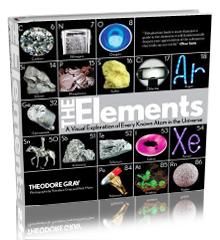Real visible fluorine. | |||
| Sample Image | |||
| Real visible fluorine. I used to think that there was no known transparent container that could contain fluorine without getting eaten by it. Then I got this email: Now, respectfully, I must take up a little bit of a qualm with your claim in fluorine...You mention that "There is no transparent container that will hold it." Granted that is true if you're talking a "forever" time scale, but I strongly believe on a "realistic" scale (a few decades) it can be done...albeit with some difficulty and great time placed into it. The way best to do it is first to get yourself a pure, single-crystal quartz tube...Now that means one with an extremely high amount of surface Si-O-Si bonds and VERY few Si-OH endcaps. The best way to do this is to take the inside portion of the quartz tube and silylate it. Then anneal it at the highest possible temperature that your annealing oven can stand...This will drive off essentially ALLLLLLL the Si-OH end caps. Because remember, the real killer in fluorine gas for Si-O's is not the fluorine, but the OH's and their ability to start a chain reaction with small amounts of HF in the fluorine gas. So, the first thing you need to do is get rid of the Si-OH's which that should take care of as best as possible. Now, being absolutely certain that your quartz tube is flamed and ultra-dry, there's another step...There was a fluorocarbon grease that DuPont made many years ago that was ultra-high-purity completely fluorinated, medium-high mol.weight fluorocarbon grease (like a lower-molecular weight Teflon)...Take that stuff and literally melt it into the tube...It's clear and translucent and won't affect the optics after the next step...So then take a high temperature vacuum oven and turn the tube upside down and melt the grease back out...What this does is leave a verrrrry thin, essentially invisible layer of fluorocarbon grease layer on the inside of the tube. This layer acts as a secondary "buffer" layer to the quartz. So IF there are any Si-OH's left on your quartz, they are difficult to get at by the fluorine gas because the fluorine gas has a difficult time penetrating the grease...This step will add years to your fluorine gas display. Then the more difficult thing to do is to make sure the quartz tube has a high-purity Teflon screw-top stopper to it so that it can seal ultra-tightly. (again, pure fluorine gas without any water/HF in it may "trade" fluorines with Teflon, but you still have Teflon; same goes for the grease, the grease may "trade" fluorines as we've seen in some isotopic studies, but it remains a carbon-fluorine bond).I stand corrected! Not only that, he actually sent me one, it's beautiful, and just for good measure it's the 500th element sample added to my collection. He'll even make you one, if you're willing to pay the price, and based on the description above I'm sure you won't mind paying him the very reasonable couple of hundred dollars he asks. Click the Source link for more information and a link to his eBay auctions. Source: Greg P Contributor: Greg P Acquired: 18 April, 2003 Text Updated: 20 November, 2008 Price: Donated Size: 7" Purity: >99% | |||
|

